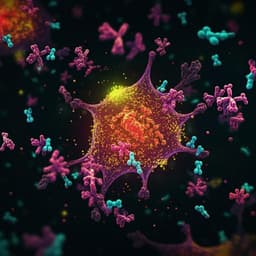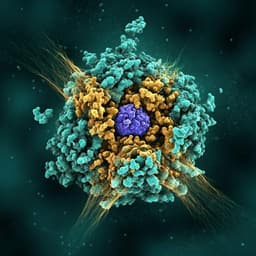
Medicine and Health
Regorafenib plus nivolumab in unresectable hepatocellular carcinoma: the phase 2 RENOBATE trial
H. Kim, S. Jung, et al.
Discover the promising results of combining Regorafenib and nivolumab in treating unresectable hepatocellular carcinoma. This phase 2 trial led by Hyung-Don Kim and colleagues reveals an objective response rate of 31% and highlights significant immune response changes in long-term responders. A must-listen for anyone interested in innovative cancer therapies!
Playback language: English
Introduction
Multiple phase 3 trials have demonstrated that anti-PD-1 antibody monotherapy, both in first-line and second-line settings, fails to improve overall survival (OS) in patients with unresectable hepatocellular carcinoma (uHCC). However, recent trials like IMBrave 150 and HIMALAYA showed OS benefits with first-line combination therapies of anti-PD-L1 plus anti-VEGF (atezolizumab-bevacizumab) and anti-PD-L1 plus CTLA-4 (durvalumab-tremelimumab), respectively, compared to sorafenib. Furthermore, a recent first-line phase 3 trial showed that rivoceranib (a VEGFR2-targeted tyrosine kinase inhibitor) plus camrelizumab (an anti-PD-1 antibody) significantly improved progression-free survival (PFS) and OS compared to sorafenib. Despite these successes, other first-line phase 3 trials combining anti-PD-1/PD-L1 with VEGF-targeted multi-kinase inhibitors (MKIs) haven't shown survival benefits over MKI monotherapy (e.g., COSMIC-312, LEAP-002). These inconsistent results suggest that clinical efficacy might depend on the detailed molecular and immunological mechanisms of the combination partners, particularly in ICI-based combination treatments.
Regorafenib, an MKI with anti-angiogenic activity, inhibits various targets and has shown improved survival outcomes in patients with uHCC after sorafenib progression. Its modulation of the VEGFR and CSF1R pathways suggests a potential to reverse myeloid cell immunosuppression and enhance anti-tumor immune responses. Inhibition of the CSF1R pathway could specifically polarize myeloid cells toward anti-tumor responses. Myeloid cells are heavily implicated in HCC immune evasion and ICI response, making the regorafenib-ICI combination a strong rationale. While CheckMate 459 showed a trend toward improved survival with nivolumab monotherapy in the first-line setting compared to sorafenib, it didn't reach statistical significance. Given regorafenib's anti-tumor activity and immunomodulatory potential, combining it with nivolumab could offer clinically meaningful benefits in uHCC. Despite several reported biomarkers associated with uHCC clinical outcomes under ICI treatment, none are firmly established as predictive of ICI response, highlighting the need for further mechanistic investigation into ICI-based treatment response and resistance. The RENOBATE trial, a multicenter phase 2 study, was designed to evaluate the efficacy and safety of the regorafenib-nivolumab combination as a first-line treatment for uHCC, incorporating a comprehensive biomarker study including ctDNA, single-cell RNA sequencing (scRNA-seq), TCR repertoire analysis, and multicolor flow cytometry using serially collected PBMCs.
Literature Review
The current standard of care for first-line treatment of unresectable hepatocellular carcinoma (uHCC) has evolved significantly with the introduction of combination therapies involving immune checkpoint inhibitors (ICIs) and anti-angiogenic agents. Prior to these advancements, sorafenib served as the primary first-line treatment option, however, its limitations in terms of overall survival (OS) benefits prompted the search for more effective strategies. Several phase 3 clinical trials have demonstrated improved outcomes with combination regimens. The IMBrave 150 trial showcased the benefit of atezolizumab (an anti-PD-L1 antibody) combined with bevacizumab (an anti-VEGF monoclonal antibody), while the HIMALAYA study highlighted the efficacy of durvalumab (anti-PD-L1) plus tremelimumab (anti-CTLA-4). These studies have established combination immunotherapy as a superior approach compared to sorafenib monotherapy. The CARES-310 trial further demonstrated the advantage of combining an anti-PD-1 antibody (camrelizumab) with a VEGFR2-targeted tyrosine kinase inhibitor (rivoceranib), leading to significant improvements in PFS and OS. However, the landscape is not without inconsistencies. Some trials involving other multi-kinase inhibitors (MKIs) combined with ICIs have not shown the same level of OS benefit. The COSMIC-312 trial (cabozantinib plus atezolizumab) and LEAP-002 trial (lenvatinib plus pembrolizumab) exemplify this variability. Understanding the underlying reasons for these discrepancies is crucial for optimizing treatment strategies.
Methodology
This open-label, multicenter, single-arm, phase 2 RENOBATE trial was conducted at three academic institutions in South Korea. Forty-two patients with unresectable HCC (BCLC stage B or C, ineligible or refractory to transarterial chemoembolization, no prior systemic chemotherapy) were enrolled between July 24, 2020, and February 16, 2021. Key inclusion criteria included histologically/cytologically confirmed HCC, unresectable disease, no prior systemic therapy for HCC, ECOG performance status 0 or 1, Child-Pugh class A, and at least one measurable lesion by RECIST v1.1. Patients received nivolumab (480 mg on day 1) and regorafenib (80 mg daily, days 1-21) every 4 weeks. Response was assessed every 8 weeks using RECIST v1.1. Safety was evaluated at specified time points according to NCI-CTCAE v5.0. The primary endpoint was the investigator-assessed objective response rate (ORR) per RECIST v1.1. Secondary endpoints included safety, ORR per modified RECIST, PFS, and OS. Exploratory endpoints involved biomarker analysis using ctDNA sequencing, scRNA-seq, and flow cytometry on PBMCs collected at baseline and during treatment.
The sample size calculation was based on Fleming’s single-stage phase 2 design, aiming for an ORR of 25% with a power of 90% and a two-sided alpha of 0.05, adjusted for anticipated follow-up loss. Efficacy analysis used the intention-to-treat population, while the safety analysis set included all patients receiving at least one dose. Subgroups for exploratory endpoints were defined post-hoc based on response: early progressors (disease progression at the first evaluation or progressively increased tumor burden) and long-term responders (decreased tumor burden for at least 10 months).
ctDNA analysis used the Guardant360 CDx platform. scRNA-seq data were processed using Seurat, with quality control, batch effect correction, and unsupervised clustering. Differential gene expression analysis was performed, and gene set enrichment analysis was conducted using publicly available gene sets. Pseudotime analysis and interactome analysis (CellChat) were used to investigate dynamic changes and intercellular communication. Multicolor flow cytometry was used to validate scRNA-seq findings. Statistical analyses were performed using SAS, Prism, and R.
Key Findings
In the RENOBATE trial, the combination of regorafenib and nivolumab met its primary endpoint, achieving an investigator-assessed objective response rate (ORR) of 31.0% per RECIST v1.1 in the intention-to-treat population. This exceeded the predefined threshold of ≥25%. One patient (2.4%) achieved a complete response (CR), and 12 patients (28.6%) achieved a partial response (PR). The most frequent adverse events were palmar-plantar erythrodysesthesia syndrome (38.1%), alopecia (26.2%), and skin rash (23.8%). Grade 3 adverse events were observed in 10 patients (23.8%), with increased aspartate aminotransferase being the most common. No grade 4 adverse events or treatment-related deaths were reported.
Secondary endpoints revealed a median progression-free survival (PFS) of 7.38 months (95% CI, 4.12-13.0 months) and a 1-year PFS rate of 37.8%. The 1-year overall survival (OS) rate was 80.5% (95% CI, 63.0-90.3%), and the median OS was not reached. The median duration of response was 10.3 months. The most common reason for drug discontinuation was adverse events leading to discontinuation of either regorafenib or nivolumab, but not both. No patient discontinued both due to AEs.
Exploratory single-cell RNA sequencing (scRNA-seq) analyses of peripheral blood mononuclear cells (PBMCs) from long-term responders (n=15) and early progressors (n=14) revealed distinct immune landscapes. Long-term responders showed increased TCR repertoire diversification, enrichment of genes associated with immunotherapy responsiveness (e.g., in MK167 proliferating CD8+ T cells), and a higher probability of M1-directed monocyte polarization. They exhibited increased proportions of proliferating CD8+ T cells, enhanced cytotoxic activity (Granzyme B+/perforin+ cells), and upregulation of cytotoxicity-related genes in MK167+ CD8+ T cells. In contrast, early progressors showed enrichment of immunosuppressive tumor-associated macrophages and upregulation of TMEM176A/B, which inhibits the inflammasome response, suggesting a potential mechanism for resistance.
Discussion
The RENOBATE trial demonstrated the clinical activity and favorable safety profile of the regorafenib-nivolumab combination as a first-line treatment for uHCC. The observed ORR and PFS were comparable to other first-line anti-PD-1/L1-VEGF-targeted MKI combinations or atezolizumab-bevacizumab. The lower incidence of grade 3-4 adverse events compared to other regimens might be attributed to the reduced regorafenib dose. The single-cell analyses provided unique insights into the dynamic immune responses, revealing distinct patterns in long-term responders versus early progressors. The findings suggest that regorafenib’s modulation of myeloid cells (M1 polarization) might contribute to the improved efficacy. The TCR repertoire diversification and increased proliferative burst of CD8+ T cells in long-term responders are consistent with previous studies on ICI-based treatments. The diverging monocyte responses, particularly the M1 polarization in long-term responders and the enrichment of immunosuppressive TAMs in early progressors, warrant further investigation. The association of TMEM176A/B upregulation with early progression highlights a potential target for overcoming resistance to ICI-based therapies.
Conclusion
Regorafenib-nivolumab demonstrates clinical activity and is well-tolerated as a first-line treatment for uHCC. The exploratory biomarker analyses provide insights into immune responses and potential targets for overcoming resistance to ICI-based treatments. Further investigation of this combination is warranted.
Limitations
The absence of a control group (nivolumab monotherapy) limits the interpretation of regorafenib's additive effect. The exploratory nature of the biomarker analyses and the post-hoc definition of subgroups based on response should be considered. The small sample size and lack of tissue-based correlatives are also limitations. Finally, the regorafenib-responsive gene sets may not fully reflect its effects in all HCC patients. The small sample size in certain biomarker analysis is also a limitation.
Related Publications
Explore these studies to deepen your understanding of the subject.







